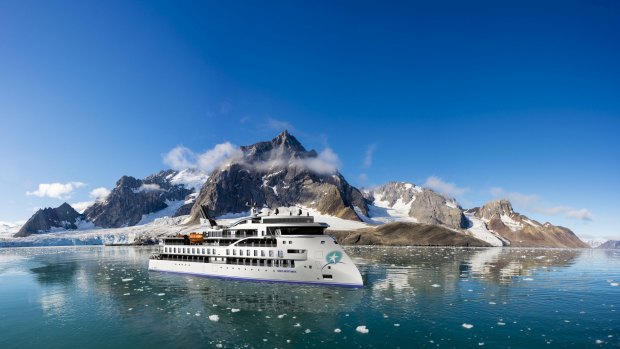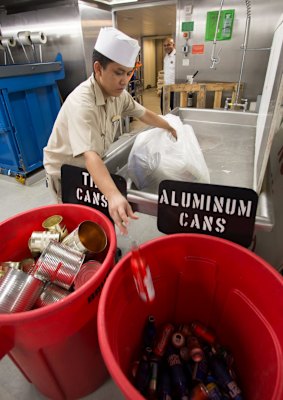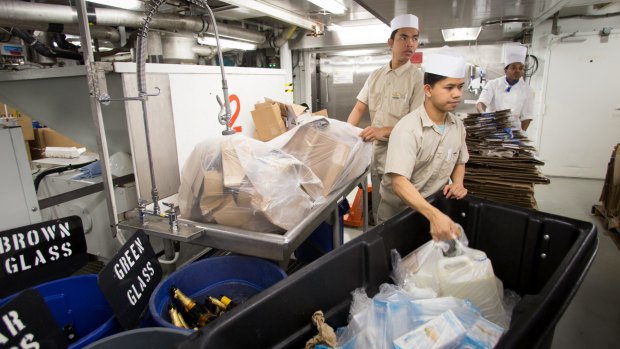This was published 5 years ago
Cruising and the impact on the environment: How cruise lines are becoming more sustainable
By Ute Junker

Aurora Expeditions' new ship Greg Mortimer will feature technology that allows the company to decrease its environmental impacts even further.
Exploring the temples at Angkor Wat is one of the highlights of any Mekong River cruise, but it can be thirsty work. Which is why, when passengers aboard the Scenic Spirit head off on their Angkor Wat excursion, many of them pack not just their phone and their sunscreen, but also a refillable water bottle they have bought onboard the ship.
The bottles are more than just a tactic to reduce single-use plastics; the purchase price helps to fund community projects.
"The money that we make we put back into clean water initiatives in Cambodia," says Anthony Laver, Scenic's general manager for sales and marketing. "We have put a pipeline into one local village and built a utilities block in another village, providing clean water and clean toilet facilities. It all goes straight back to the communities."

Crew on Harmony of the Seas separate recyclables.
Supporting local communities is just one of the areas where Scenic is looking to make a difference. The company has instituted a number of changes aimed at improving its environmental credentials, covering everything from reducing the environmental impacts of ship operations to replacing printed guest surveys with electronic versions. Other cruise lines are also increasingly focused on making their operations more sustainable, a change that is driven in part by customer demand.
"As a company, we have long been committed to sustainability. However, we are also aware that guests that sail with us expect us to be stewards of the environment," says Susan Bonner of Royal Caribbean Cruises. "They are keen to learn about our sustainability initiatives, and we get very positive feedback on them."
Almost every decision that a cruise company makes – from the fuel that it uses to the shape of the ship's bow to how it treats wastewater – has an impact on the environment. Particularly for companies that operate in some of the world's most fragile environments, finding ways to mitigate the impacts of their operations is a core concern.

Recycling onboard Harmony of the Seas.
"We respect the environment in which we are operating, which is why we believe in doing more than just meeting the legal requirements," says Sarina Bratton, chairwoman Asia Pacific of Ponant. "We belong to [voluntary] organisations such as IAATO [International Association of Antarctic Tour Operators], which impose much tighter regulations about how to operate in these environments."
Ponant's investment in new technology is exemplified by its newest icebreaker, currently under construction, which draws on hybrid power including liquefied natural gas, electric and battery power. Although Ponant's ships already use the less-polluting marine gas oil instead of the heavy oil that some companies rely on, this technology opens new frontiers for Ponant.
"It means you can go into an area such as the North Pole and just rely on electric power. Conceivably we will have no noise, no vibrations; that is the first time that has been done in an icebreaker," Bratton says.
Sustainability is about more than just the operation of the ship, however. Ponant's other initiatives range from facilitating scientific research – the new ship will have an onboard lab – to building effective relationships with local communities. The latter is particularly important in some of the less developed areas where Ponant operates.
"It takes about two years to curate a new itinerary in a new area, because we need to engage with the community elders," Bratton says. "Building relationships takes time, as does negotiating access and discussing the benefit for the community.
"In some of these areas, money doesn't really mean anything. If malaria is an issue, it may be more useful to provide mosquito nets for the community. Or we may build a school house for the children, or bring our doctor ashore if someone is not well."
The ships in Ponant's fleet are small by industry standards, carrying fewer than 300 passengers. By contrast, Royal Caribbean's fleet includes ships that carry more than 5000 passengers. Susan Bonner, the company's managing director Australia and NZ, says Royal Caribbean is committed to ongoing investment in sustainability.
"We focus on continuous improvement in how we treat both air and water, whether that is introducing new technology on new ships or retro-fitting older ships," Bonner says. "We look at everything from improving propulsion systems to revisiting energy management."
A well-designed ship can dramatically reduce environmental impacts. Bonner says Royal Caribbean's Quantum class ships are a good example. "The Quantum class ships utilise a specialised hull design that captures micro-bubbles. The system significantly reduces drag, improving fuel efficiency by 10 per cent," she says. .
Two years ago, Royal Caribbean entered into a ground-breaking partnership with the World Wide Fund for Nature (WWF) to reduce the company's environmental impacts. "We have already made great progress," Bonner says. "Our goal is to reduce greenhouse gas emissions by 35 per cent by 2020; through our investment in advanced emission purification systems, we have already reduced them by 25 per cent."
The WWF partnership addresses other issues, too, including the food that passengers and crew eat.
"We have made a commitment to sourcing 90 per cent of our food locally, and to have 100 per cent cage free eggs by 2022," Bonner says. Royal Caribbean has also promised by 2020 that 1000 of its shore excursions will be supplied by operators certified as sustainable.
"Setting those targets is essential," Bonner says. "It's like losing weight. Saying you are going to do it is great, but if you don't have a goal, you won't get there."
In an era in which over-tourism is an issue, larger cruise ships are often singled out as culprits. Popular ports such as Venice and Dubrovnik have complained that thousands of day-tripping cruise passengers have a physical impact on a city but bring no corresponding economic benefit.
Bonner says Royal Caribbean is working to address those concerns. "It is about having a mutual conversation and looking at what we do," she says. "I believe the crux of the concern around over-tourism is about how we distribute guests, so we are looking at how we do shore excursions, what the available infrastructure is, and how we can improve in that field."
Another company re-examining its operations is Australia's Aurora Expeditions. The company, which specialises in Antarctic and Arctic cruises, has been a pioneer for sustainability since launching 27 years ago. However, managing director Robert Halfpenny says Aurora has recently raised the bar when it comes to environmental responsibility.
"It has always been a core value of the company, but I saw that we could take it to another level," he says. "It is one of the top three things we talk about in meetings, and we have now put it as a deliverable in everyone's performance agreement. So many great ideas have come out of that.
"Take the polar jackets we supply to our guests onboard the Polar Pioneer. They used to be delivered to us in individual plastic bags; we realised that was unnecessary. We also looked at the food we serve on board and found changes we could make there, such as no longer using individually-wrapped portions of butter, jam and yoghurt.
"Our people are always looking at ways we can reduce, reuse and recycle."
Not every decision is clear-cut, however. Take the question of bedding. "We had to choose between using cotton or mixed poly-cotton for the doona covers," Halfpenny explains. "Cotton takes longer to dry, so there is an energy cost associated with that. However, the problem with polyester is that during each wash, micro-fibres are released and make their way into the environment. So in the end we decided that the cotton was the better choice."
Next year Aurora Expeditions will unveil a ship that will set new standards for the company. While there are plenty of features that passengers will be excited about, including the spacious cabins and the Zodiac platforms that will make boarding the inflatables much easier, Halfpenny says the ship's technology will allow the company to decrease environmental impacts even further.
"Using dynamic positioning with the ship's thrusters means we don't have to drop anchor; something that is particularly important when you are in a fragile reef environment," he says. The x-bow design of the hull promises to give passengers a smoother ride, but Halfpenny says it also brings significant eco benefits.
"It reduces the rock and roll sensation, which is particularly important when you cross a body of water like the Drake Passage [on the way to Antarctica]," Halfpenny says. "Instead of taking two days to cross the Drake, we should be able to do it in a day and a half. That means we will use much less fuel – and it also means our passengers will be able to land much sooner."
FIVE WAYS CRUISING IS BECOMING MORE SUSTAINABLE
FUEL
Many ships are moving away from the traditional heavy fuels to alternative technologies, such as marine gas oil or liquefied natural gas.
DESIGN
New hull designs are reducing drag on the ship, which in turn reduces the amount of fuel used.
FOOD
Companies are looking at their supply chains and sourcing sustainable fish, free range eggs and locally-sourced produce.
SHORE EXCURSIONS
Cruise lines are increasingly working with communities, particularly in remote parts of the world, to design itineraries that showcase cultures and reduce impacts.
ENERGY EFFICIENCY
A range of efficiency measures is being adopted across various companies, from using LED instead of incandescent lights to introducing key-card systems that switch off power and air conditioning when cabins are empty.
Sign up for the Traveller Deals newsletter
Get exclusive travel deals delivered straight to your inbox. Sign up now.